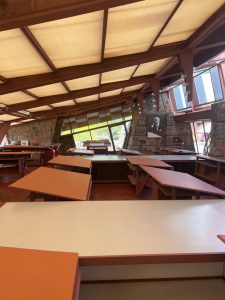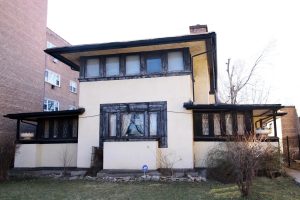


I written about the “Father of American Architecture” as well a visit a number of homes he designed in Los Angeles, such as the Hollyhock House. And, if you are ever in Scottsdale, I recommend visiting Taliesin West. Above are a few images from my visit.
I am passionate about historic homes because they tells about who we are as well a level of craftsmanship and materials rarely found today. With that background, you will understand why this article by Katherine McLaughlin for Architectural Digest made me a little sad:
 A Frank Lloyd Wright home, Getty image on left, in Chicago has been placed on a list of the most endangered historic buildings in the city, reports Austin Weekly News, a local Windy City paper. Preservation Chicago, a nonprofit advocacy organization that protects local architecture, recently named the home, known as the J.J. Walser Jr. House, on its list of the Chicago 7 Most Endangered. Ward Miller, Preservation Chicago’s executive director, tells AD that the annual list “is our way of sharing with the public, City of Chicago officials, stakeholders, and owners our collective concerns for these structures and to spotlight them. It’s our hope that this list will encourage a good preservation outcome, and in some cases, new stewards for these troubled buildings and sites.”
A Frank Lloyd Wright home, Getty image on left, in Chicago has been placed on a list of the most endangered historic buildings in the city, reports Austin Weekly News, a local Windy City paper. Preservation Chicago, a nonprofit advocacy organization that protects local architecture, recently named the home, known as the J.J. Walser Jr. House, on its list of the Chicago 7 Most Endangered. Ward Miller, Preservation Chicago’s executive director, tells AD that the annual list “is our way of sharing with the public, City of Chicago officials, stakeholders, and owners our collective concerns for these structures and to spotlight them. It’s our hope that this list will encourage a good preservation outcome, and in some cases, new stewards for these troubled buildings and sites.”
Located in the Austin neighborhood on the city’s west side, the residence was designed in 1903 for Grace and J.J. Walser, a local couple. The home is finished in a tan stucco—which at the time was a unique material to use—with dark wood trim. In fact, the house appeared in a 1905 article in House Beautiful about the growing use of plaster and cement in home construction. Overhanging eaves and a hipped roof firmly establish the residence in the Prairie style, and in 1984 the home was designated a Chicago landmark. In 2013, it was listed on the National Register of Historic Places.
Built for $4,000 (about $143,000 today), it is one of the best examples of Wright’s early pursuits of inexpensive, well-designed homes. He would continue to rethink and reconfigure the Walser plan for future projects, and its influence can be seen in the Barton House in Buffalo, New York; the DeRhodes House in South Bend, Indiana; and the Horner House in Chicago, which was demolished in 1952.
The Walsers sold the property in 1910 after having lived in it for seven years. Over the next six decades, the home changed hands 11 times—simultaneously undergoing a series of renovations and remodels—before it was purchased by its most recent owners, Anne and Hurley Teague, in 1970. “Austin has experienced much disinvestment over the past half century, which has also impacted the property and its value,” Miller explains. “Its longtime owners tried their very best to maintain the home, despite the costs associated with some of the various needs and requirements, as they continued to age.”
Today, the house is in dire need of repairs. “The home is a work of art, and like many houses and buildings designed by Wright, it requires special attention for repairs and maintenance,” Miller says. “This is to be expected for any older property, but especially for those buildings designed by someone as notable and famous.”
Twenty years ago, the owners took out a reverse mortgage on the property (a loan secured by the home’s equity), but since Anne’s death in 2019 the interest from the loan has become unbearable for her heirs. The residence has remained unoccupied since. In 2024, the Frank Lloyd Wright Conservancy flagged the threats facing the home, noting that “every part of this house needs attention.” The stucco and wood trim are deteriorating and there are holes in the foundation and upper north wall. The conservancy initiated temporary enclosure efforts, which have momentarily stopped water from coming into the home
Currently, the home is going through a foreclosure suit, but the lengthy process is derailing efforts to find a new steward. “The mortgage companies do not realize the immediate and expensive repairs required to stabilize the building,” Miller adds. As a landmark building, the residence is safe from intentional demolition, but natural threats and delayed maintenance pose great risks.
“The next steps are to encourage all stakeholders and the lenders to work together to resolve the many issues tied to [the home’s] ownership,” Miller says. “We need the community to voice their support for this amazing house and be a partner in its restoration, repair, and revival. To that end, we also need the City of Chicago to assist with some of the funds needed to bring back Wright’s vision for this landmark building.”

 Facebook
Facebook
 X
X
 Pinterest
Pinterest
 Copy Link
Copy Link


